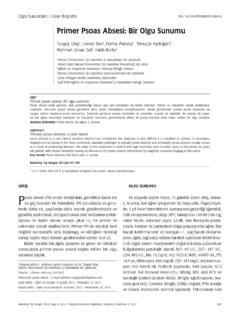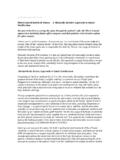Transcription of 263 Lumbar Plexus Block - Psoas Compartment Block
1 Sign up to receive ATOTW weekly - email ATOTW 263 Lumbar Plexus Block Landmark Technique ( Psoas Compartment Block ) 18/06/2012 Page 1 of 9 Lumbar Plexus Block LANDMARK TECHNIQUE ( Psoas Compartment Block ) ANAESTHESIA TUTORIAL OF THE WEEK 263 18TH JUNE 2012 Katie Patton1 and Paul Warman2 1. Torbay Hospital, Torquay 2. Leeds General Infirmary, Leeds Correspondence to QUESTIONS Please answer the following questions either true or false: 1. The following nerves arise from the Lumbar Plexus ; a. Lateral Cutaneous Nerve of the Thigh b. Obturator nerve c. Tibial nerve d. Saphenous nerve e. Sural nerve 2. Stimulation of hamstrings or knee flexion are acceptable motor responses using the PNS prior to LA injection. 3. Complications of Lumbar Plexus Block include; a. Epidural Block b. Sub arachnoid/intrathecal injection c. Cardiovascular collapse d. Psoas muscle haematoma e.
2 Renal capsular haematoma INTRODUCTION The Lumbar Plexus describes the origins of 4 of the nerves supplying the lower limb (femoral, lateral cutaneous nerve of the thigh, obturator and genitofemoral) along with the ilioinguinal and illiohypogastric nerves. Blockade of the Plexus has been described since the early 1970s and is a useful technique for providing analgesia of large parts of the leg. It is principally used for post-operative analgesia for major orthopaedic surgery of the hip, femur and knee. Since Winnie s original description of the posterior approach to the Lumbar Plexus in 1974 there have been several alterative descriptions, which will be described and discussed in this article. Capdevilla s description, essential a modification of Winnie s original technique, developed from CT anatomic studies, is probably the current technique of choice.
3 Although Winnie described an anterior approach (via the femoral nerve) to the Lumbar Plexus Block (the so called 3 in 1) in 1973, subsequent studies have shown the Plexus is not at all reliably blocked via injections at this site and therefore will not be discussed in this tutorial. Publication in 2002 of a large study from France raised concerns over the safety of Lumbar Plexus blocks as the incidence of serious complication was calculated as 80 per 10,000 compared to an overall incidence of 5 per 10,000 for regional anaesthetics. This was principally attributed to inadvertent epidural and intrathecal spread or administration of local anaesthetic drugs. However, with appropriate skills and training it remains a useful and safe technique for regional anaesthetists. This Tutorial will cover the relevant anatomy, a description of the posterior approaches blocking the Lumbar Plexus (and the debate about the merits of each) and complications.
4 Ultrasound guided techniques will not be covered in this article. There is also a brief review of the literature surrounding the use of Lumbar Plexus blocks in clinical practice. Sign up to receive ATOTW weekly - email ATOTW 263 Lumbar Plexus Block Landmark Technique ( Psoas Compartment Block ) 18/06/2012 Page 2 of 9 ANATOMY The Lumbar Plexus describes the association of nerves derived from the segmental Lumbar spinal roots. The Lumbar Plexus receives input from L1 (variable input from T12) to L4 and produces the femoral nerve, lateral cutaneous nerve of the thigh, obturator nerve, as well as the iliohypogastric, ilioinguinal and genitofemoral nerves. Lumbar Plexus Origins The Lumbar Plexus is formed from the ventral rami of L1-L3 (sometimes including T12), with a major contribution from L4. The nerve roots then run anteriorly to form the Lumbar Plexus , which lies between the quadratus lumborum and Psoas major muscles.
5 The Plexus and branches then angle caudally to descend within the mass of the Psoas major muscle, anterior to the transverse processes of the Lumbar vertebrae. The L1 nerve root (occasionally with a contribution from T12), splits into an upper and a lower branch. The upper branch then divides into the iliohypogastric and ilioinguinal nerves. The lower branch forms the genitofemoral nerve with a contribution from L2 nerve root. The ventral branches of L2, L3 and L4 form the obturator nerve. The dorsal roots of L2 and L3 have lesser branches, which make up the lateral cutaneous nerve of the thigh, and greater branches, that along with the dorsal root of L4 are the origins of the femoral nerve. Figure 1. Lumbosacral Plexus The femoral nerve is the largest terminal branch of the Lumbar Plexus . It emerges from the lower part of the Psoas major muscle and iliacus muscle deep to the iliacus fascia.
6 It innervates the pectineus muscle before entering the thigh by passing underneath the inguinal ligament to lie lateral to the femoral artery. It provides sensory supply to the anterior thigh and the medial lower leg, and motor supply to the quadriceps muscle. Sign up to receive ATOTW weekly - email ATOTW 263 Lumbar Plexus Block Landmark Technique ( Psoas Compartment Block ) 18/06/2012 Page 3 of 9 The obturator nerve also descends through the Psoas major muscle and emerges near the pelvic brim. It enters the thigh by passing through the obturator foramen, where it divides into the anterior and posterior branches. Motor supply is to the obturator externus and adductor muscles, with sensory innervations to the hip and knee joints. Sensory innervation, and therefore Block , can be variable, with adductor muscle weakness being the most reliable sign of obturator nerve Block .
7 The lateral cutaneous nerve of the thigh arises from the lateral part of the Psoas muscle and crosses the iliacus, running towards the anterior superior iliac spines. It passes under the inguinal ligament 1cm medial to the anterior superior iliac spines to supply sensory innervation to the anterior and lateral aspects of the thigh. The iliohypogastric nerve divides into the anterior and lateral cutaneous branches just above the iliac crest. The anterior cutaneous branch innervates the skin over the anterior aspect of the abdomen above the pubis, and the lateral branch supplies the skin over the posterolateral aspect of the gluteal region. The ilioinguinal nerve emerges caudal to the iliohypogastric nerve at the lateral border of the Psoas muscle. It provides sensory innervation to the superomedial thigh and genital region. The genitofemoral nerve divides into genital and femoral branches.
8 The genital branch supplies the skin of scrotum in men and the skin of the mons pubis and labium majus in women. The femoral branch lies lateral to the femoral artery in the femoral sheath and supplies sensory innervations to the skin over the upper part of the femoral triangle. INDICATIONS This Block is mainly indicated for the management of pain following unilateral lower limb surgery principally of the knee, femur or hip. It is less useful as a sole anaesthetic technique because there is no blockade of the sciatic nerve, which has major innervation of the posterior thigh, the lower leg and usually has some innervation of both the hip and knee joint. Thus complete anaesthesia or analgesia of the whole lower limb requires the addition of a sciatic nerve Block Alternatives for providing regional anaesthesia or analgesia of the lower limb are central neuroaxial blockade: Epidural or Sub-Arachnoid (spinal) technique.
9 These techniques generally produce bilateral effects such as reduced mobility, which may be undesirable or unnecessary, and are frequently associated with the risk of urinary retention. They also have their own risks and complications, especially the feared epidural haematoma or abscess. Lumbar Plexus Block General considerations As with all regional anaesthesia procedures: consent must be obtained from the patients, iv access established and standard monitoring attached, resuscitation facilities must be available and the procedure carried out in an aseptic manner. Lumbar Plexus blocks, like all regional anaesthetic techniques, should ideally be performed on awake or lightly sedated patients, however many practitioners will safely undertake the Block following general or spinal anaesthesia. At least some sedation is recommended for posterior approaches to the Lumbar Plexus because it is a deep Block , with the needle having to pass through a reasonable amount of muscle mass.
10 A small, sub-cutaneous and intradermal injection of lidocaine (or similar) at the point of needle insertion is recommended for patient comfort. Absolute contraindications Patient refusal Local anaesthetic allergy Local sepsis or infection at puncture site (or within Psoas muscle) INR > or < 12 hours post LMWH (many practitioners consider a posterior approach to Lumbar Plexus comparable to central neuroaxial blockade.) Sign up to receive ATOTW weekly - email ATOTW 263 Lumbar Plexus Block Landmark Technique ( Psoas Compartment Block ) 18/06/2012 Page 4 of 9 Relative contraindication and cautions Systemic sepsis, especially for catheter placement. Poor cardiac function or fixed cardiac output The risk of epidural and subarachnoid spread from the posterior approaches means that caution should be exercised in considering this Block in patients with poor cardiac function or fixed cardiac output.

















